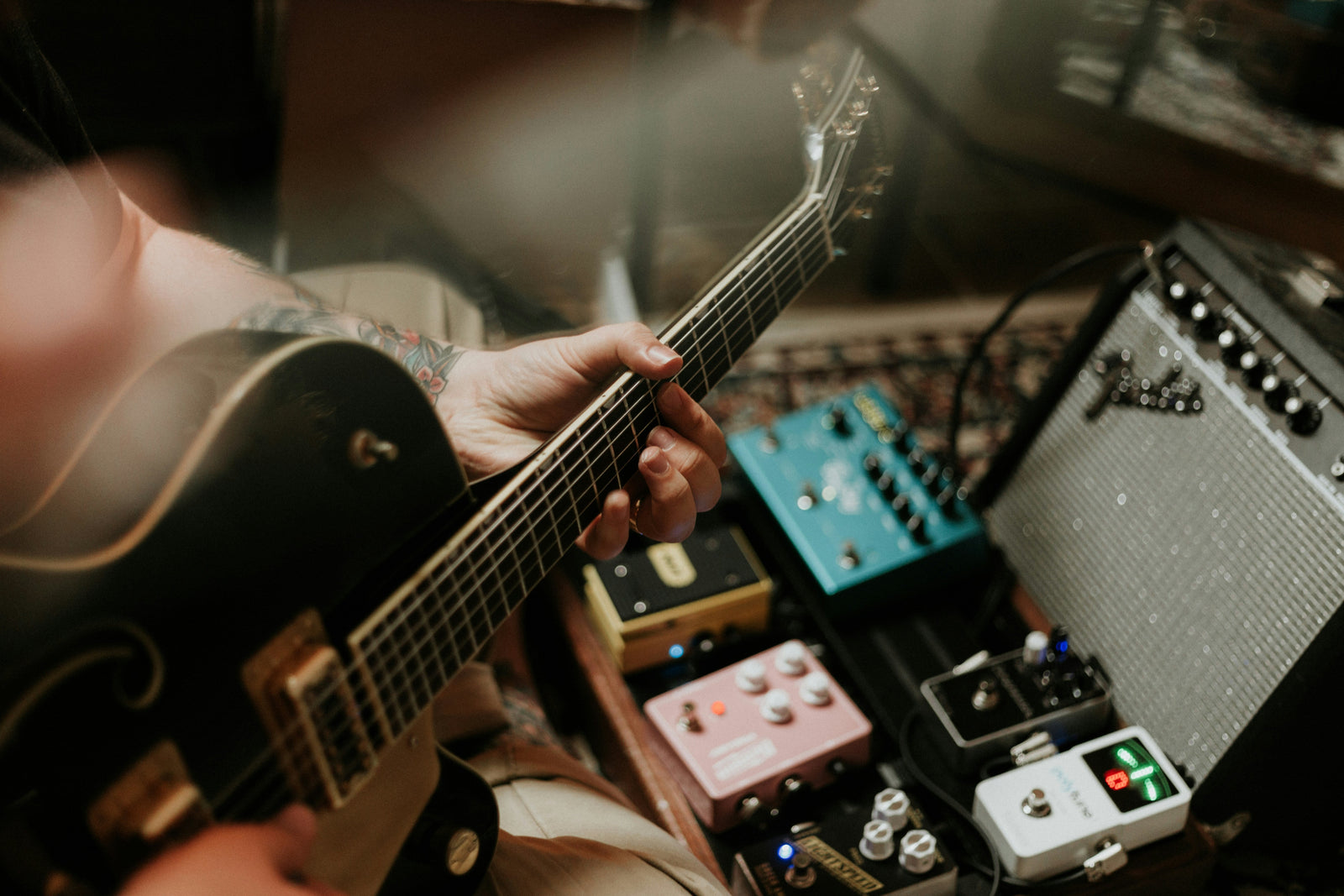Guitar Tuner Instrument Insider: Top Picks for Ukulele, Bass, Electric, and Acoustic Tuning
A guitar tuner instrument ensures your instrument sounds its best. Whether you're tuning a ukulele, bass, electric, or acoustic guitar, accuracy matters.
A tuner helps you stay in tune, providing consistent, high-quality sound. With so many tuners available, finding the right one is key. Some tuners specialize in certain instruments, while others offer universal tuning options.
We'll explore the best tuners for each instrument, helping you choose wisely. Whether it's a clip-on tuner, pedal tuner, or app, the right tool makes tuning easy.
By understanding different tuners, you'll ensure your instrument always sounds great.
Guitar Tuner Instrument: Why Tuning Matters for Every Instrument
Precise tuning is vital for ukuleles, bass, electric, and acoustic guitars. Accurate tuning ensures consistent sound quality, helping musicians create pleasing melodies. When instruments are out of tune, the result can be jarring and unpleasant. This disrupts the listener's experience and undermines the musician's performance.
Proper tuning allows musicians to play and blend with others. For instance, in a band setting, a bad-tuned bass can throw off the entire rhythm section. An electric guitar out of tune creates discord in solos, disrupting the musical flow. Ukuleles and acoustic guitars also need to be in tune for chord progressions to sound clean.
Tuning Accuracy and Performance
Accurate tuning affects performance quality and listener experience. If an instrument is in tune, it blends very well with other sounds, creating a rich and harmonious mix. For instance, a well-tuned ukulele can deliver crisp and joyful melodies. This can enhance any performance.
For bass guitars, accurate tuning means tight and consistent rhythms. It anchors the band's sound. A tuned bass guitar provides a solid musical foundation. Electric guitars rely on precise tuning for expressive solos and vibrant chord progressions.
Acoustic guitars sound warm and inviting when in tune. Yet, even slight discrepancies can produce a dissonant twang. Accurate tuning ensures that chord changes are smooth, and fingerpicking patterns resonate well.
There are several reasons why instruments go out of tune:
- String Stretching: New strings need time to stretch and stabilize.
- Temperature and Humidity: Environmental factors affect wood and string tension.
- Playing Intensity: Aggressive playing or bending can cause strings to slip.
By tuning instruments, musicians can mitigate these issues and maintain performance quality. A reliable guitar tuner ensures accurate tuning for various guitars and ukuleles. This enables confident and consistent playing.
Exploring Top Guitar Tuner Instruments
|
Tuner Model |
Ukulele |
Bass |
Acoustic |
Electric |
All Instruments |
|
Clip-on Tuners |
|||||
|
✓ |
✓ |
✓ |
✓ |
✓ |
|
|
✓ |
✓ |
✓ |
✓ |
✓ |
|
|
✓ |
✓ |
✓ |
✓ |
✓ |
|
|
✓ |
✓ |
✓ |
✓ |
✓ |
|
|
✓ |
✓ |
✓ |
✓ |
✓ |
|
|
✓ |
✓ |
✓ |
✓ |
✓ |
|
|
✓ |
|||||
|
✓ |
✓ |
||||
|
✓ |
✓ |
✓ |
|||
|
✓ |
✓ |
||||
|
✓ |
✓ |
||||
|
✓ |
|||||
|
✓ |
|||||
|
✓ |
✓ |
||||
|
✓ |
✓ |
||||
|
✓ |
✓ |
✓ |
✓ |
✓ |
|
|
✓ |
|||||
|
✓ |
✓ |
||||
|
✓ |
|||||
|
MiniPitch Series |
✓ |
✓ |
✓ |
||
|
PC-0 Series |
✓ |
✓ |
✓ |
||
|
✓ |
✓ |
✓ |
✓ |
✓ |
|
|
✓ |
✓ |
✓ |
✓ |
✓ |
|
|
✓ |
✓ |
✓ |
✓ |
✓ |
|
|
✓ |
✓ |
✓ |
|||
|
✓ |
✓ |
✓ |
|||
|
Rack-mounted Tuners |
|||||
|
✓ |
✓ |
✓ |
|||
|
Sound Hole Tuner |
|||||
|
✓ |
|||||
|
Pedal Tuners |
|||||
|
TU-3 Series |
✓ |
✓ |
✓ |
✓ |
✓ |
|
Pitchblack Series |
✓ |
✓ |
✓ |
✓ |
✓ |
|
Handheld Tuners |
|||||
|
CA Series |
✓ |
✓ |
✓ |
||
|
GA Series |
✓ |
✓ |
✓ |
✓ |
✓ |
|
✓ |
✓ |
✓ |
|||
|
Tuner & Metronome Combo |
|||||
|
✓ |
✓ |
✓ |
|||
|
✓ |
✓ |
✓ |
|||
|
TM-50 Series |
✓ |
✓ |
✓ |
✓ |
✓ |
|
TM-60 Series |
✓ |
✓ |
✓ |
✓ |
✓ |
Best Guitar Tuner Instrument for Ukulele
Handheld Tuners: CA-50
The CA-50 provides high-precision tuning in a compact, portable form. It suits a variety of instruments with its enhanced screen for easier reading. The LCDs have a needle meter that shows pitch accuracy and a note name. This makes tuning straightforward for beginners and pros alike. It has a detection range from A0 to C8. It accommodates instruments from piccolos to contrabasses.
A built-in sensitive mic ensures accurate note detection in different settings. You can attach an external contact mic for precise tuning in noisy areas. The tuner also highlights pure major and minor third intervals. It is useful for ensemble harmony and vocal practices.
Best Guitar Tuner Instrument for Bass
Clip-on Tuners: PitchCrow-G
The PitchCrow-G is a compact clip-on tuner known for its light, streamlined design. It's about 20% smaller and lighter than older models. This tuner boasts a vivid full-color LCD and specific modes for guitar and bass.
Key features include:
- Ultra-high precision tuning with accuracy up to ±0.1 cents.
- Long battery life allows up to 24 hours of use.
- Optimized display reduces edge space for better visibility.
KORG has designed the PitchCrow-G to be practical yet highly accurate. It supports easy tuning for both beginners and professionals. Specialized modes cater to guitar and bass, with added settings for flat and capo tuning. This tuner is ideal for musicians needing reliable, portable tuning.
Best Guitar Tuner Instrument for Electric Guitar
Clip-on Tuners: Pitchclip 2
The Pitchclip 2 is KORG's updated clip-on tuner, known for quick, accurate tuning. It attaches to your guitar's headstock and activates with a switch. It also displays the tuning status immediately.
Here are some key points:
- Enhanced precision ensures tuning your guitar.
- Stronger clip boosts hold by 140%, ensuring stability.
- Adaptable display aids left-handed users.
The LED display shows the tuning accuracy, and its design suits any electric guitar. Compact enough to carry in a pocket, it's perfect for musicians on the go. The Pitchclip 2 works in various lighting, making it versatile for different settings.
Best Guitar Tuner Instrument for Acoustic Guitar
Clip-on Tuners: Pitchclip 2+
The Pitchclip 2+ tunes each performance for guitarists.
- The enhanced LED display now includes 17 LEDs for more detailed pitch visualization.
- High-precision tuning capability with ±0.1 cent accuracy for optimal sound.
- Adjustable screen orientation allows for easy viewing from various angles.
This tuner suits daily use across different instruments. It provides both precision and convenience. It improves upon its predecessor by offering a clearer and more adaptable display. Also, a more secure clip that doesn't need readjusting. The Pitchclip 2+ delivers reliable performance every time.
Tuning Techniques for Different Instruments Using a Guitar Tuner Instrument
Tuning a Ukulele
To tune a ukulele, start by identifying the standard G-C-E-A tuning. The string arrangement comprises G, C, E, and A. Clip the tuner onto the headstock or place it nearby if it's a pedal tuner. Pluck each string one by one, adjusting the tuning pegs until the tuner indicates that the string is in tune.
- Start with the G string and pluck it.
- Adjust the tuning peg until the tuner shows a green or middle indicator.
- Move to the C string and repeat the process, ensuring it stays in tune.
- Tune the E string next, making small adjustments to achieve perfect pitch.
- Finally, tune the A string and verify that each string remains in tune.
Double-check the tuning by playing simple chords like C, F, and G.
Tuning a Bass Guitar
In standard tuning, bass guitars tune from the lowest to the highest string: E-A-D-G.
Follow these steps to achieve accurate bass tuning:
- Start with the E string and pluck it.
- Adjust the tuning peg until the tuner shows a stable reading at E.
- Move to the A string and repeat the process, making small adjustments.
- Tune the D string next, ensuring it matches the correct tuner.
- Finish by tuning the G string to the perfect pitch.
Bass guitars often need a more sensitive tuner due to their lower frequencies. Play a simple riff to ensure the strings are in tune and harmonize well.
Tuning an Electric Guitar
Electric guitars use standard tuning (E-A-D-G-B-e), but alternate tunings are common.
Here’s a step-by-step guide to standard tuning:
- Start with the low E string and pluck it.
- Adjust the tuning peg until the tuner reads an accurate E.
- Move to the A string and repeat the process until it reads A.
- Tune the D string next, ensuring the tuner reads D.
- Tune the G string, then move to the B string for an accurate pitch.
- Finally, tune the high E string, checking each string for accuracy.
For Drop D tuning, lower the low E string to D while keeping the other strings standard. Play power chords to verify tuning.
Tuning an Acoustic Guitar
Tune acoustic guitars the same way as electric guitars.
For standard tuning, follow these steps:
- Start with the low E string and pluck it.
- Adjust the tuning peg until the tuner shows a correct E-reading.
- Tune the A string, ensuring it matches the tuner.
- Tune the D string next, followed by the G string.
- Move to the B string and tune it to the correct pitch.
- Finish by tuning the high E string and check all strings again.
For alternate tunings like DADGAD or Open G, tune each string one by one to match the required notes. Strum open chords to verify the tuning.
Key Features to Look For in a Guitar Tuner Instrument
Choosing the right guitar tuner instrument requires understanding essential features. A good tuner ensures accurate tuning for any instrument.
Here are key features to consider:
Tuning Modes and Calibration Range
Tuning modes and calibration range are vital for versatility.
- Tuning Modes: Chromatic, strobe, and polyphonic modes offer flexible options.
- Chromatic mode helps tune any instrument by identifying all 12 notes.
- Strobe mode provides the highest accuracy, ideal for studio use.
- Polyphonic mode lets you tune all strings simultaneously, saving time.
- Calibration Range: Allows adjusting the reference pitch from A=410Hz to 480Hz.
- The standard pitch is A=440Hz, but some musicians prefer alternative ranges.
- A broader calibration range is useful for orchestral instruments and non-standard tunings.
Accuracy and Speed
High accuracy and speed are crucial for professional use.
- Accuracy: Measured in cents, where one cent equals one-hundredth of a semitone.
- Tuners with ±0.1 cents accuracy provide precise tuning, perfect for live gigs.
- For beginners, ±1 cent accuracy is often enough.
- Speed: Fast response time helps musicians tune at ease between songs.
- Pedal tuners and polyphonic tuners generally offer the quickest response.
- Clip-on tuners with vibration sensors also provide speedy, noise-free tuning.
Display Brightness and Visibility
Bright and readable displays are essential, especially for live settings.
- Display Brightness: LED or OLED screens provide excellent visibility on stage.
- Some tuners allow brightness change to suit different lighting conditions.
- Auto-dimming screens prevent distractions during quiet or lit moments.
- Display Size and Angle: Large screens are easier to read, especially in low light.
- Clip-on tuners with swivel heads offer adjustable viewing angles.
- Pedal tuners placed on the floor should have a clear, upright display.
Durability and Battery Life
Durable build quality and long battery life ensure reliability.
- Durability: Metal housings and reinforced clips withstand rigorous use.
- Pedal tuners with metal enclosures are ideal for stage performances.
- Clip-on tuners with reinforced plastic provide lightweight durability.
- Battery Life: A long-lasting battery is essential for uninterrupted tuning.
- Pedal tuners often use 9V batteries or external power supplies for consistent power.
- Clip-on tuners with lithium coin batteries offer hours of continuous use.
- Auto power-off features save battery life when the tuner isn't in use.
Considering these features helps musicians find a tuner that meets their needs. A tuner improves quality when tuning a ukulele, bass, electric, or acoustic guitar. It also enhances the listener experience.
Guitar Tuner Apps vs. Physical Guitar Tuner Instruments
Comparing guitar tuner apps and physical instruments reveals different strengths for each. This section evaluates which might be better suited for different musicians' needs.
Overview of Top Guitar Tuner Apps
Guitar tuner apps have become popular due to their convenience and versatility.
Here are some of the best apps to consider based on their features, feedback, and reliability:
1. Fender Tune
- Offers 22 tunings for guitars and ukuleles, with an easy interface and learning tools. It is ideal for beginners.
2. Guitar Tuna
- Supports many instruments with an easy-to-use interface, metronome, and learning games. Known for its accuracy.
3. TunerPro
- Features precision pitch detection and supports various tunings. It includes chromatic modes, suited for professionals.
4. BOSS Tuner App
- Delivers chromatic tuning with a needle-style display, designed for various instruments. It is mirroring BOSS's physical tuners.
5. CarlTune - Chromatic Tuner
- Provides a colorful display and supports many instruments. It includes options for standard, alternate, and custom tunings.
6. Pano Tuner - Chromatic Tuner
- Known for its responsive interface and accurate pitch detection. It supports various frequencies and is easy to use.
These summaries highlight each app’s key features and suitability for different users. These are suitable for both beginners to professionals.
Comparing Accuracy and Usability
|
Feature |
Guitar Tuner Apps |
Physical Guitar Tuner |
|
Accessibility |
Accessible via mobile or desktop |
Requires a physical device |
|
Accuracy |
Accurate with a good microphone, can vary with the device |
Generally very accurate, less dependent on external factors |
|
Instrument Support |
Can support many instruments, versatile |
Often specific to one or a few instruments |
|
Tuning Modes |
Standard, alternate, chromatic |
Standard, alternate, chromatic |
|
Learning Tools |
Often includes chord libraries, metronomes, games |
Rarely includes extra features |
|
Convenience |
Instant tuning anywhere with internet access |
Requires carrying the tuner, but no need for internet |
|
Use in Live Settings |
Less ideal in noisy environments without quality microphones |
Excellent for live use due to direct instrument connection |
This table should illustrate why some musicians prefer digital convenience. Others rely on the reliability and robustness of physical tuners. This is true in live performance settings where accuracy and speed are crucial.
Guitar Tuner Instruments Conclusion
Choosing the right guitar tuner is essential for optimal sound. Whether using an app or a physical tuner, each offers unique benefits. Key features like accuracy, usability, and tuning modes are crucial. Consider what you need for performances, recordings, or practice. A reliable tuner ensures instruments are perfectly pitched for any musician. The best tuner fits your musical activities, enhancing your performances reliably.





